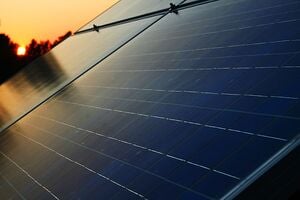
Solar power is the conversion of energy from sunlight into electricity. It can be done directly using photovoltaics (PV), indirectly using concentrated solar power, or a combination. Photovoltaic cells convert light into an electric current using the photovoltaic effect. Concentrated solar power systems use lenses or mirrors and solar tracking systems to focus and concentrate a large area of sunlight to a small beam or point.
It is generally considered to be "Green", renewable, sustainable, and environmentally friendly. With an increasing cost of energy and alternative energies, solar power is becoming more economically feasible and important in many areas such as solar lighting.
History[edit | edit source]

Passive solar building designs have been used for thousands of years so that the walls and floor absorb heat during the day and releas it at night. If you have ever stood in the sun to warm your body up, then you too have harvested energy from the sun for warmth. In fact, the history of the solar energy dates back to 7th century B.C. and multiple events in ancient times have shaped the future discovery of the solar power system, as we know it today..[1] In 1839 a french physicist, Edmond Becquerel, first showed photovoltaic activity. He discovered that electrical current could be increased in certain materials when exposed to light. Albert Einstein built up this finding 66 years later to what we know know as the photoelectric effect. Electrons are emitted from matter due to their absorption of energy from electromagnetic radiation, specifically very short wavelengths such as ultraviolet (UV) radiation.
Photovoltaics[edit | edit source]
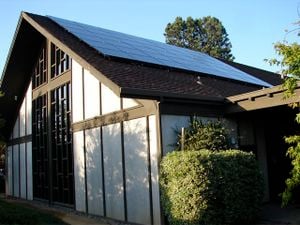
Photovoltaics (PV) is a method of generating electrical power by converting solar radiation into direct current electricity using semiconductors that exhibit the photovoltaic effect. Photovoltaic power generation employs solar panels comprising a number of cells containing a photovoltaic material. Materials presently used for photovoltaics include monocrystalline silicon, polycrystalline silicon, amorphous silicon, cadmium telluride, and copper indium selenide/sulfide.
Due to the growing demand for renewable energy sources, the manufacturing of solar cells and photovoltaic arrays has advanced considerably in recent years.[2][3][4] This article explores the components of a photovoltaic system, describes their role and importance, and works as a beginning guide to those wishing to invest in a photovoltaic system.
Concentrated solar power[edit | edit source]
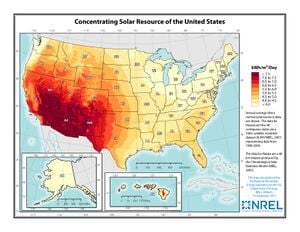
Concentrated Solar Power (CSP) takes the sun's energy and collects it through a series of arrays and then concentrates or focuses it on a location that is the center of the arrays. The energy at that central point becomes very hot, hot enough to melt many metals and to produce steam. Most notable of these arrays are the large installations of heliostats (mirrors), which track the Sun and reflect the radiant energy to a receiver on a tall tower. A very few smaller systems use Fresnel lenses or parabolic reflectors to concentrate the solar thermal energy. There are a lot of advantages of solar power
Heliostats[edit | edit source]
A heliostat is a device that includes a mirror, usually a plane mirror, which turns so as to keep reflecting sunlight toward a predetermined target, compensating for the sun's apparent motions in the sky. The target may be a physical object, distant from the heliostat, or a direction in space. To do this, the reflective surface of the mirror is kept perpendicular to the bisector of the angle between the directions of the sun and the target as seen from the mirror. In almost every case, the target is stationary relative to the heliostat, so the light is reflected in a fixed direction.
The principal uses of heliostats are for daylighting (bringing daylight into a space that would otherwise be poorly illuminated), and in the generation of electricity in solar-thermal power stations. They are also occasionally used, or have been used in the past, in surveying, in astronomy and other sciences, to produce very high temperatures in solar furnaces, to improve illumination for agriculture, and to direct constant sunlight onto solar cookers. During the 19th Century, they were used by painters and other artists in order to provide constant, bright illumination of their subjects.
Heliostats should be distinguished from solar trackers or sun-trackers, which always point directly at the sun in the sky. However, some types of heliostat incorporate sun-trackers, together with additional components to bisect the sun-mirror-target angle.
Solar thermal energy[edit | edit source]
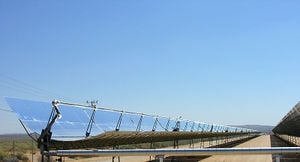
Solar thermal energy (STE)[5] is a technology for harnessing solar energy for thermal energy (heat).
Solar thermal collectors are classified by the USA Energy Information Administration as low-, medium-, or high-temperature collectors. Low temperature collectors are flat plates generally used to heat swimming pools. Medium-temperature collectors are also usually flat plates but are used for heating water or air for residential and commercial use. High temperature collectors concentrate sunlight using mirrors or lenses and are generally used for electric power production. STE is different from photovoltaics, which convert solar energy directly into electricity. While only 600 megawatts of solar thermal power is up and running worldwide in October 2009 according to Dr David Mills of Ausra, another 400 megawatts is under construction and there are 14,000 megawatts of the more serious concentrating solar thermal (CST) projects being developed.[6]
Solar power tower[edit | edit source]
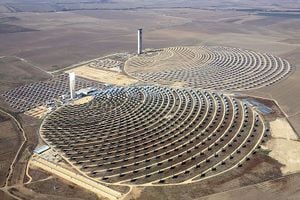
A solar power tower is a type of indirect solar power technology. Solar power is electricity produced from the radiation of the sun. The energy of the sun can be captured and converted into power directly with Photovoltaic solar panels (PV) or indirectly by solar thermal conversion using Concentrated solar power (CSP) technology.[7]CSP technology uses thermal energy from the sun to heat a liquid, such as water or molten salt. This heat transferring liquid is used to vaporize water to the point of steam, which is then used to generate electricity in a traditional turbine-generator. Power plants using CSP technology include parabolic trough, parabolic dish and solar power tower systems.[8]
Achieving economies of scale[edit | edit source]
There is a need to increase demand for photovoltaics such that they can compete with conventional electricity production methods. One innovative idea is to harness the green purchasing power of academic institutions. This has been shown to be potentially quite influential in catalyzing a positive spiral-effect in renewables globally.[9] open access
See also[edit | edit source]
- Solar power in space
- Argentina photovoltaic
- Robin deterrent for solar charger
- Solar Shack
- Performance of U.S. hybrid distributed energy systems: Solar photovoltaic, battery and combined heat and power
- Lunar solar power generation
References[edit | edit source]
- ↑ Superior Solar - History of solar energy, "Solar Energy Timeline - Infographic".
- ↑ German PV market
- ↑ BP Solar to Expand Its Solar Cell Plants in Spain and India
- ↑ Large-Scale, Cheap Solar Electricity
- ↑ "It's solar power's time to shine". MSN Money. Retrieved 2008-06-05.
- ↑ Manning, Paddy (10 October 2009). "With green power comes great responsibility". Sydney Morning Herald. Retrieved 2009-10-12.
- ↑ Robles, Pedro. "PS20 Tower". Abengoa Solar. June 12, 2010. [1]
- ↑ Richter, Dr. Cristoph. "CSP- Technology". SolarPACES. June 12, 2010. [2]
- ↑ Joshua M. Pearce, "Catalyzing Mass Production of Solar Photovoltaic Cells Using University Driven Green Purchasing", International Journal of Sustainability in Higher Education, 7(4), pp. 425 – 436, 2006.